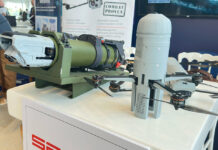
IMSAR successfully flight-tested an extended range multi-mode radar, the NSP-5 ER, for the first time. During the flight, the new sensor underwent testing to verify that image quality and impulse response metrics met IMSAR standards, delivering high-resolution imaging and coherent change detection modes. Following the successful flight test IMSAR began integration of the radar onto the Beechcraft King Air 200 for its first customer. In May 2018 the new radar was delivered to a Beechcraft King Air 200 customer.
According to the manufacturer’s technical specifications, the NSP-5 ER that operates in the Ku band can spot a 1-meter object in SAR image from 30 km on land, and detect moving targets (GMTI) from 20 km. Image resolution can be refined well below one meter, to 30 cm and lower. The complete, self-contained 58 inches (147 cm) long podded system weighs 10.9 kg (24 lbs) and consumes less than 275 watts of aircraft power.
Previously reserved for small Unmanned Aerial Vehicles, IMSAR has increased the operating range of their low Size, Weight, Power, and Cost (SWaP-C) multi-mode radar. The NSP-5 ER was designed for higher-altitude operation on larger, faster aircraft such as the King Air, PC-12, Caravan, and Gray Eagle. The NSP-5 ER provides these platforms with the same capabilities and low SWaP-C currently available on small UAVs while increasing range.
Previously reserved for Group 2 and Group 3 UAVs, IMSAR increased the operating range of their low Size, Weight, Power, and Cost (SWaP-C) multi-mode NSP-5 radar. The NSP-5 ER is designed for higher-altitude operation on larger, faster manned or unmanned aircraft such as the King Air, PC-12, Caravan, and Gray Eagle. The NSP-5 ER provides these platforms with the same capabilities and low SWaP-C currently reserved for smaller UAVs at lower speeds and altitudes. The radar has Synthetic Aperture Radar (SAR), Coherent Change Detection (CCD), Ground Moving Target Indicator (GMTI) and Maritime Moving Target Indicator (MMTI) modes.




















